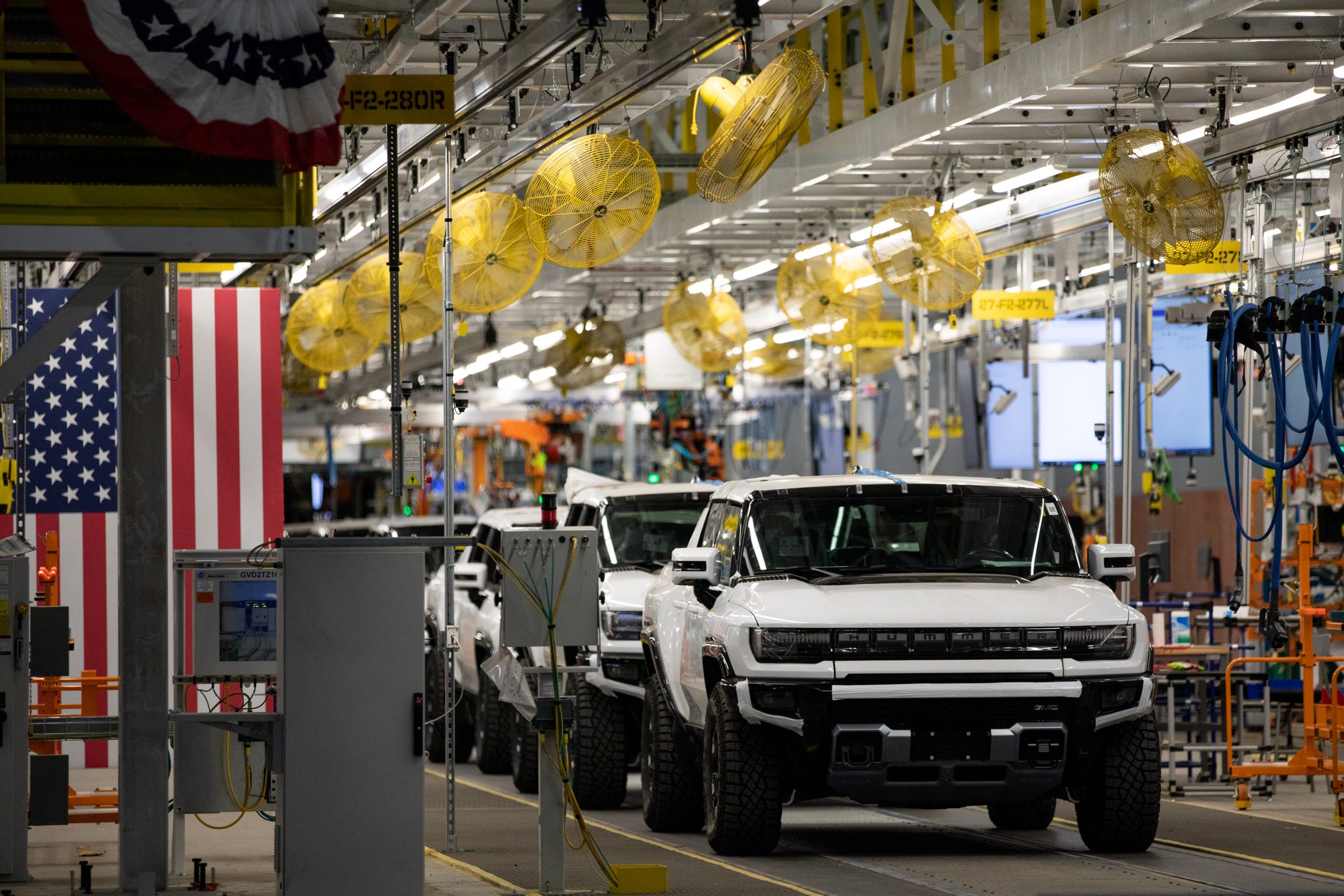
General Motors, a cornerstone of the American automotive industry, is undertaking significant workforce adjustments within its electric vehicle (EV) and battery manufacturing operations across the United States. This strategic realignment involves the indefinite layoff of approximately 1,200 employees at its Detroit EV factory, alongside additional temporary reductions and the idling of its Ultium Cells battery production facilities in Ohio and Tennessee. The Ultium plants are slated to pause operations beginning January 5, with production anticipated to resume in mid-2026, signaling a substantial, albeit temporary, deceleration in battery output.
This move follows a series of internal reevaluations by the automaker, including recent layoffs affecting its white-collar workforce and a substantial $1.6 billion financial charge incurred as it recalibrates its ambitious electrification plans. The decision to scale back production and staffing comes amidst a broader industry shift, where the pace of EV adoption is proving more complex than initial projections, influenced by evolving consumer demand, regulatory environments, and the withdrawal of certain federal incentives.
A Strategic Recalibration
The current adjustments mark a pivotal moment for General Motors, which has, in recent years, positioned itself as a leader in the global transition to electric mobility. The company’s pronouncements of an “all-electric future” and its stated goal to phase out gasoline-powered vehicles by 2035 have been central to its long-term vision. This commitment was underpinned by massive investments in its proprietary Ultium battery platform and dedicated EV manufacturing facilities across North America.
However, the reality of market dynamics and the complexities of scaling up an entirely new vehicle architecture are prompting a more measured approach. The decision to reduce staff and idle key production sites suggests a recognition that the anticipated rapid acceleration of EV demand may not be materializing at the aggressive rates initially forecast. This is not an abandonment of the electric future but rather a tactical pause and a strategic re-evaluation of the rollout timeline and production volumes. It reflects a pragmatic response to current market conditions, aiming to synchronize supply with evolving demand.
The Road to Electrification: Ambitious Beginnings
General Motors’ journey toward an electrified portfolio gained significant momentum in the late 2010s and early 2020s. Following early forays like the Chevrolet Volt plug-in hybrid and the all-electric Bolt EV, the company unveiled its groundbreaking Ultium battery technology in March 2020. This modular platform was touted as the cornerstone of GM’s next-generation EVs, designed to power a diverse range of vehicles, from compact cars to large trucks and SUVs, with significant range and performance capabilities.
The Ultium strategy involved a multi-billion-dollar investment plan, including the construction of dedicated battery cell manufacturing plants through a joint venture with South Korean energy giant LG Energy Solution, dubbed Ultium Cells LLC. The first of these plants, located in Warren, Ohio, began production in late 2022, followed by a second facility in Spring Hill, Tennessee, with a third under construction in Lansing, Michigan, and a fourth planned for New Carlisle, Indiana. These facilities were designed to produce millions of battery cells annually, crucial for meeting GM’s ambitious EV production targets. The goal was to reach 1 million units of EV production capacity in North America by 2025.
Parallel to these manufacturing investments, GM outlined an aggressive product roadmap, promising 30 new global EV models by 2025 across its various brands, including Chevrolet, Cadillac, GMC, and BrightDrop. This era was characterized by a bullish outlook on EV adoption, fueled by government incentives, rising environmental consciousness, and a growing consensus that the automotive industry was on an irreversible path toward electrification.
Navigating Shifting Sands: Market Realities and Policy Changes
The current adjustments by GM are deeply intertwined with a confluence of evolving market conditions and policy shifts. While global EV sales continue to grow, the rate of growth has moderated in key markets, including the United States. Several factors contribute to this moderation:
- Consumer Adoption Pace: Initial projections often underestimated the challenges of widespread consumer adoption. Factors such as higher upfront costs for EVs compared to internal combustion engine (ICE) equivalents, persistent concerns about charging infrastructure availability and speed, and "range anxiety" continue to influence purchasing decisions for a segment of the market.
- Economic Headwinds: High interest rates and broader economic uncertainties have impacted new car sales across the board, making consumers more cautious about large purchases, especially those with a premium price tag like many EVs.
- Regulatory Environment: The federal government’s approach to incentivizing EVs has seen shifts. The loss of eligibility for certain federal tax credits under Section 30D of the Inflation Reduction Act for some EV models, due to strict domestic content and battery sourcing requirements, has undoubtedly impacted consumer affordability. While these credits aim to bolster domestic supply chains, their immediate effect has been to reduce the pool of eligible, affordable EVs for buyers. Furthermore, there have been discussions and proposals regarding the loosening of certain regulatory restrictions on internal combustion vehicles, potentially reducing the urgency for automakers to push EVs aggressively to meet emissions targets. This creates a less stringent environment for ICE vehicles, allowing automakers more flexibility in their product mix.
These external pressures have prompted many automakers, not just GM, to re-evaluate their EV strategies. Companies like Ford and Mercedes-Benz have also announced adjustments to their EV production targets or investment timelines, indicating a broader industry recalibration rather than an isolated incident for GM.
The Financial Toll and Portfolio Adjustments
The financial impact of this recalibration is substantial for General Motors. The $1.6 billion charge linked to the rework of its EV plans reflects the costs associated with scaling back production, retooling, and potentially absorbing inventory or contractual obligations related to its ambitious earlier targets. Such charges indicate a recognition of past overestimations or unforeseen obstacles, necessitating a significant financial write-down.
Adding to this strategic shift was GM’s recent decision to discontinue its BrightDrop commercial electric van program. BrightDrop, launched with much fanfare, aimed to provide electric delivery vans and associated logistics software for fleet customers. Its cessation signifies GM’s effort to streamline its EV portfolio, shedding ventures that may not be meeting performance expectations or align with the company’s refined core strategy. This consolidation suggests a focus on its passenger vehicle segment and perhaps a more selective approach to commercial EV opportunities, where market penetration and profitability are proving more challenging than anticipated. The closure of BrightDrop, while a relatively niche program, sends a clear signal about GM’s willingness to make tough decisions to optimize its overall EV strategy.
Impact on the Workforce and Local Economies
The human element of these adjustments is profound. The indefinite layoff of 1,200 workers at the Detroit EV factory, along with temporary cuts and plant idlings at the Ultium Cells facilities in Ohio and Tennessee, directly impacts thousands of families. "Indefinite layoff" implies an uncertain return date, differing significantly from temporary furloughs, which typically have a clearer timeline for re-employment. For these workers, many of whom are unionized under the United Auto Workers (UAW), this news brings considerable anxiety and financial strain.
These layoffs ripple through local economies, particularly in communities with deep roots in automotive manufacturing. Detroit, Warren, Spring Hill, and other towns hosting these facilities rely on the stability of these jobs for local businesses, housing markets, and tax revenues. The UAW, which recently secured significant wage and benefit increases for its members in new contracts with the Big Three automakers, will likely play a crucial role in advocating for affected workers, exploring options for transfers to other GM facilities, or supporting retraining initiatives. The long-term idling of battery plants also affects the broader supply chain, impacting suppliers of raw materials, components, and logistics services that feed into these operations.
Broader Implications for the EV Transition
General Motors’ actions carry significant implications for the broader electric vehicle transition in the United States and globally. As one of the world’s largest automakers, GM’s strategic adjustments serve as a barometer for the industry.
- Pace of Transition: This recalibration signals a potentially slower, more deliberate pace for the mass adoption of EVs than many had initially predicted. It suggests that while the shift is inevitable, the timeline for widespread market penetration may be extended, giving legacy automakers more time to refine their offerings and build out necessary infrastructure.
- Investment Confidence: The news could temper investor enthusiasm in the pure-play EV sector and related start-ups, prompting a more scrutinizing look at their production ramp-up capabilities and profitability timelines. It underscores the capital-intensive and challenging nature of transforming an entire industry.
- Policy Debates: This situation will undoubtedly fuel ongoing policy debates about the role of government incentives, regulatory mandates, and infrastructure investments in accelerating or slowing the EV transition. Policymakers will face renewed pressure to balance environmental goals with economic realities and consumer preferences.
- Competitive Landscape: The adjustments highlight the intense competition within the EV space, not just from established players but also from new entrants and rapidly expanding Chinese manufacturers. Automakers must constantly optimize their strategies to remain competitive and profitable in a dynamic global market.
Looking Ahead: A Measured Pace Towards an Electric Future
General Motors’ workforce reductions and production adjustments are not an indication of abandoning its electric vehicle ambitions but rather a strategic course correction. This move reflects a pragmatic response to a complex market environment, where the enthusiasm for EVs must be balanced with the practicalities of production costs, consumer demand, and infrastructure development. The $1.6 billion charge and the idling of Ultium plants underscore the financial pressures of pioneering new technologies at scale.
Experts suggest that such recalibrations are a natural part of any major industrial transition. Automakers must remain agile, adapting their production volumes and investment strategies to match evolving consumer preferences and technological advancements. While the immediate impact on workers and communities is challenging, the long-term vision for an electrified future likely remains intact for GM and the broader industry. The path to electrification, however, appears to be less of a sprint and more of a marathon, requiring sustained effort, significant investment, and a continuous adjustment to the realities of a rapidly changing automotive landscape. The coming years will reveal how effectively General Motors navigates this challenging, yet ultimately transformative, period.



